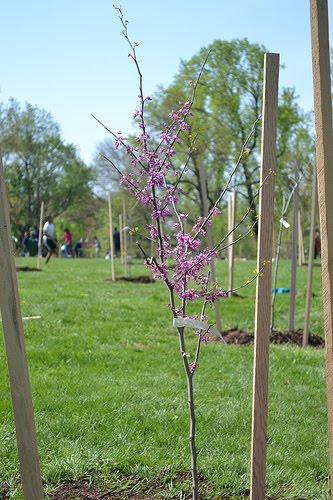Planting Your Tree
Planting trees in the landscape provide you benefits that can far exceed the costs of planting and maintaining them over their life span. These ecosystem services include cleaner air, higher property values, energy savings, increased wildlife habitat, runoff reduction and improved water quality. One study showed that 100 mature trees catch about 139,000 gallons of rainwater per year. Trees can reduce the potential negative impacts of surface water runoff by intercepting and holding large volumes of precipitation on surface areas (ie. leaves, branches and trunks) while reducing soil erosion by slowing the speed of runoff on the ground. Trees extensive roots systems increase the infiltration and storage of water in soil.
 There are many advantages to planting trees that sometimes go unnoticed. Planting a tree can be beneficial on your property for many of the following reasons:
There are many advantages to planting trees that sometimes go unnoticed. Planting a tree can be beneficial on your property for many of the following reasons:
• Trees prevent or reduce soil erosion and water pollution.
• Trees help recharge groundwater and sustains stream flow.
• When properly placed, screens of trees and shrubs significantly decrease noise pollution along busy thoroughfares and intersections.
• Screens unsightly views and softens harsh outlines of buildings.
• Provides fuelwood for stoves and fireplaces
• Provides lumber, plywood and other wood products on a sustained yield basis.
• Can reduce utility bills for air conditioning in residential and commercial buildings by 15-50 percent. Trees, through their shade and transpiration, provide natural "low-tech" cooling that means less need to build additional dams, power plants, and nuclear generators.
• Can reduce heating costs by as much as 30 percent when windbreaks are planted around homes to shield against wind and snow.
• Shade from trees cools hot streets and parking lots. Cities are "heat islands" that are 5-9 degrees hotter than surrounding areas. And cities spread each year.
• Trees and shrubs properly placed and cared for on a residential or commercial lot can significantly increase property values.
• Numerous research studies conducted in the Great Plains States have found that properly placed and cared-for field windbreaks will significantly increase crop yields compared to fields with no windbreaks, even after taking into account the space occupied by the trees. Windbreaks create a more favorable micro-climate for cropland by reducing wind and heat stress on the crop, while at the same time preventing topsoil loss and reducing soil moisture losses. During the winter, more moisture is available for use later in the year since windbreaks trap and accumulate snow that, without windbreaks, would have blown over and past the cropland and end up on roads and other breaks in topography.
• Farmstead windbreaks have many values including reduction of utility bills for cooling and heating, snow entrapment, wind reduction, aesthetics, and wildlife habitat.
• Trees also provide nutmeats (walnuts, pecans, hickory), fruit (plum, peaches, apples, pears), berries for jams and jellies (chokecherry and buffaloberry) and maple syrup.
• Tree shelters for livestock effectively reduce weight losses during cold winter months and provide shade for moderating summer heat.
• Living snowfences, strategically placed, hold snow away from roads, thus effectively reducing road maintenance costs and keeping roads open.
• Trees add beauty and grace to any community setting. They make life more enjoyable, peaceful, relaxing, and offer a rich inheritance for future generations.
• Trees give people a multitude of recreational opportunities and provide habitat for wildlife.
•Trees along rivers, streams, and lakes reduce water temperatures by their shade, prevent or reduce bank erosion and silt, and provide hiding places for improving fisheries habitat.
• They provide brilliant colors to landscapes in the fall. After the leaves drop to the ground and are raked, they provide excellent mulch for flowerbeds and gardens as well as exercise for people.
• Research indicates that trees help reduce stress in the workplace and speed recovery of hospital patients.
• Police officers believe that trees and landscaping can instill community pride and help cool tempers that sometimes erupt during "long, hot summers."
• Trees help us experience connections with our natural heritage and with our most deeply held spiritual and cultural values.
• A planted tree may provide a valuable commemorative of deceased loved ones and for passing on something of value to future generations.
• Many people enjoy planting and caring for trees simply because they like to see them grow.
• Trees renew our air supply by absorbing carbon dioxide and producing oxygen.
• Trees cool the air by evaporating water into their leaves.
• One acre of trees removes up to 2.6 tons of carbon dioxide from the atmosphere each year.
• Tree roots stabilize soil and prevent erosion.
• Shade trees can make buildings up to 20 degrees cooler in the summer.
• One tree produces nearly 260 pounds of oxygen per year.
• Trees improve water quality by slowing & filtering rain water.
• Hospital patients with a view of trees recover faster and with fewer complications than patients without a view.
• 500 trees counteract the negative environmental effects of one car for one year.


